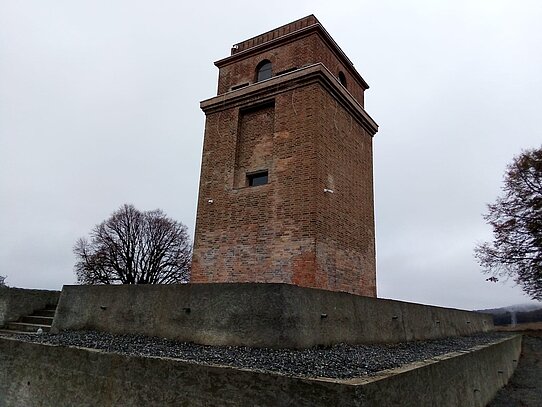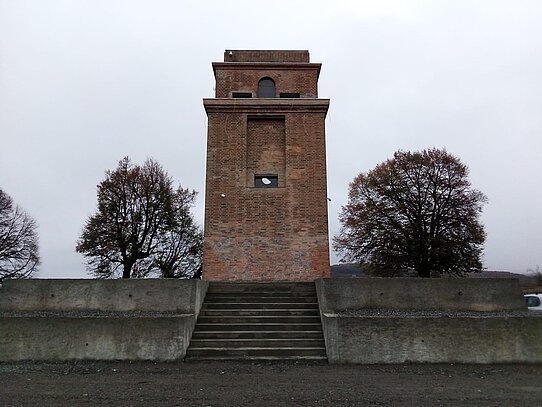THE MEMORIAL TOWER
The monument of German soldiers is located on the Gușterița Hill, the ancient name of the location, mentioned in the Josephine mapping, being Grigori Berg or Hammersdorferberg. The Memorial Tower, visible from the city, a brick construction built on a rectangular ground platform, reinforced on the sides with concrete slabs, was placed on the upper platform of the hill, an overlook over the Sibiu depression and over the peaks of the Făgăraș Mountains.
The monument of German soldiers is located on the Gușterița Hill, the ancient name of the location, mentioned in the Josephine mapping, being Grigori Berg or Hammersdorferberg. The Memorial Tower, visible from the city, a brick construction built on a rectangular ground platform, reinforced on the sides with concrete slabs, was placed on the upper platform of the hill, an overlook over the Sibiu depression and over the peaks of the Făgăraș Mountains.
The construction of this monument recalls the “Battle of Sibiu” (September 26-29, 1916), when Romanian army forces and German army forces clashed. It is possible the assumption that the tower was not built in 1916, when the German army conquered the hill. In Landwirtschaftliche Blätter (no. 41/10.13.1918) one mentions that a memorial stone was placed on the Gușterița Hill (Grigoriberg ) in memory of the “Battle of Sibiu”, before the end of the war.
The memorial service was celebrated by Father Hermann Klöss, on September 29, 1918 (two years after the events), the cemetery over there actually being opened before the completion of the monument (official “Denkmalsturm” - Landwirtschaftliche Blätter, No. 41, 13.10.1918).
The construction of a square plan, with 5.86 m side length and the approximate height of 18 m, on one side is equipped with an access door, above it, at approximately 3.5 m, there is a circular window opening on the wall, with a diameter of about 50 cm. The delimitation of the ground floor from the upper floor was done through a brick platform, currently demolished (31.05.2019).
After the inauguration of the monument (which took place two months before the Great Union of 1918), with the new political and social reality, the tower was dynamited in all the four corners, trying to tear it down. There are also traces of bullets in the body of the monument. Old photographs confirm the facts.
Returning to the architecture of the building, on the upper floor, receded from the walls, on the four sides there were openings left, with a semicircular top, three of them, being currently built. On both sides, observation slits were made, most likely by the passive defense during the World War II. Proof that these rectangular fittings reinforced with metal, did not exist during the interwar period, when around the tower the Cemetery of German soldiers was located, is in a photograph taken by Emil Fischer and reproduced on a postcard in 1942. In the postcard one mentions the fact that the picture represents: the “Cemetery of Heroes on the Gușterița Hill. Heldenfriedhof am Hammersdorferberg”. From this photo one can see the repairs performed on the three sides of the building. The platform on which the Memorial Tower was built, approximately 1 m high from the level of the hill, on the side of the city, it is equipped with 11 concrete steps. Also on the south side, the hill was consolidated by a concrete wall, drilled on the edges by staggered entrances.
Around the Memorial Tower, on all three sides, in the fall of 1918, the German army cemetery was located, which contained about 130 graves. The decision to transfer the soldiers from the place where they were initially buried, probably from the cemeteries of the towns where they had fallen in battle, occurred in 1918 and was put into practice by the local authorities. The tombstones of the graves were grouped on one side and the other of the tower, on the alignment from Sibiu being placed a row of graves.
Between 1942-1943, the Saxon Society for the Care of War Graves in Transylvania (S.K.G.F.), based in Sibiu, was in charge of dismantling small cemeteries and establishing larger cemeteries, which would include a greater number of graves. The reason given was the care of the graves, which could not have been done in the village cemeteries.
In August 1942, the marble slabs where the military rank, the name of the military, regiment to which he belonged, the year of his birth and his death were mentioned, were transferred to the Romanesque church of Cisnădioara. The bones of the soldiers were also relocated, with the help of the young ethnic Germans of the village.
In 2019, in October, the MEMORIAL TOWER was rehabilitated both inside and outside by SC URBANA SA, the administrator of the location.
DR. ADRIAN STOIA
***


